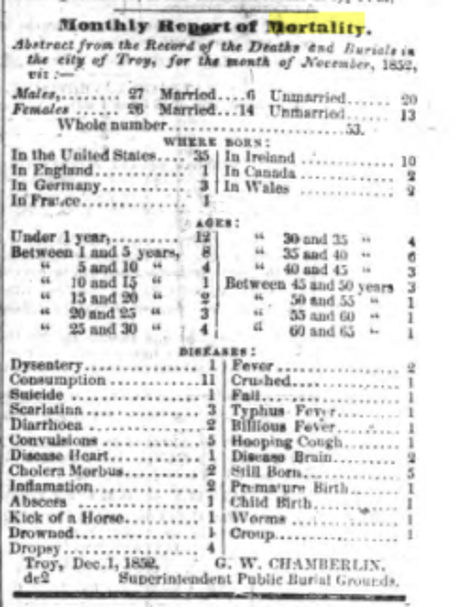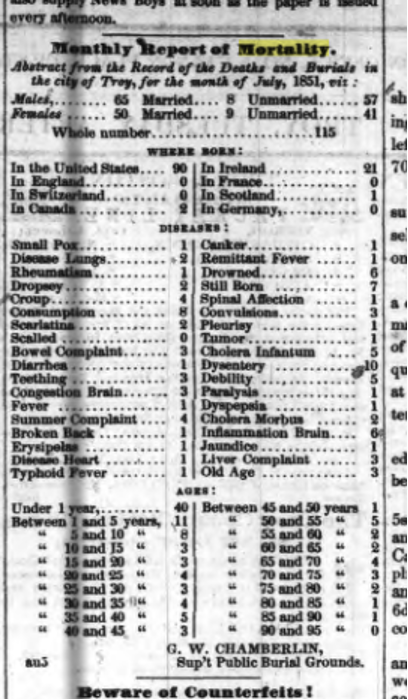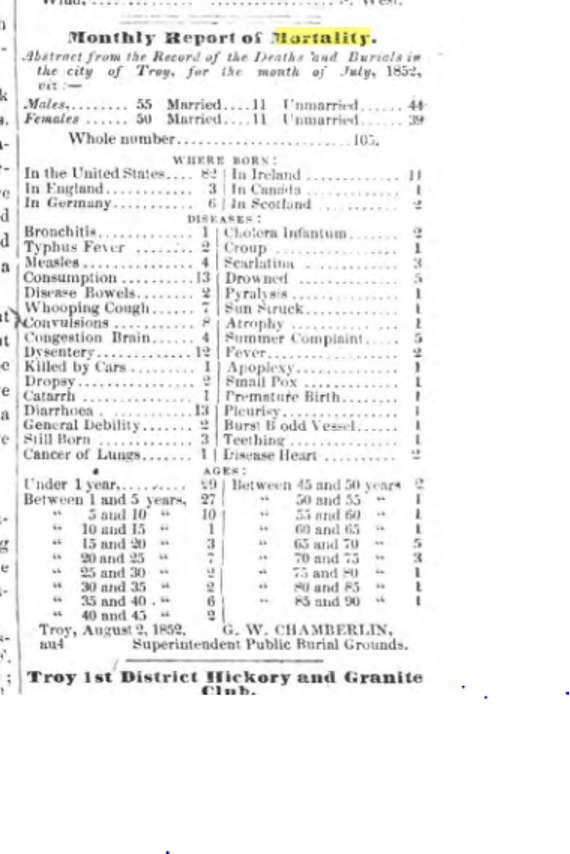Cause of Death
…as listed in the Troy Interment Records of the early 1850’s.
It is depressing and fascinating to read all of the causes of death of citizens of Troy who died in the early 1850’s. In some cases, for example cancer or heart disease, one can easily see this happening in 2024. But in other cases, the cause is something that would be easily cured today, at least in Troy, for example dysentery, or would not happen because of vaccination, for example tuberculosis. And in still other cases, the cause is a mystery to us because of either changes in terminology or advances in medicine, for example catarrh or dyspepsia.
The Troy “Daily Times” published a monthly summary of the causes of death and numbers of dead for the preceding month. In the early 1850’s, about 60 to 80 people died per month. Of those, about half were children, and about 20% were born in Ireland. The Irish were fleeing their homeland due to the potato famine, arriving in Troy in large numbers. The most common cause of death was consumption or phthisis, what we would call tuberculosis. A few folks died of scrofula, tuberculosis occurring outside the lungs.
Dysentery and diarrhea were also frequent causes- among all ages- as was cholera. Dysentery, diarrhea, and cholera still happen today in poor countries ravaged by famine or war, resulting from contaminated water and food and poor hygiene facilities. Troy still had wells and septic tanks/cess pools of some sort at this time, leading to the same conditions. In August 1851 225 people died, 87 of them of cholera, certainly an epidemic.
In mid- August 1853, at least fifteen people died of sunstroke during a heat wave in the course of a week! The Troy “Budget” of August 15 reported, “A poor laboring man named John Dorman, residing in South Troy, went up on the hill….in the rear of his residence, to read, when he was overcome by the heat and about 5 o’clock was a corpse.”
Children were still- born, or died of debility- perhaps what we would call “failure to thrive,” and of “cholera infantum”, defined as “acute gastro-intestinal catarrh (build up of mucus in an airway), with profuse vomiting, high temperature, and rapid wasting.” Amazingly to us, other children died of teething, worms, and croup, all of which occur today, but would rarely be considered life-threatening. They also died of measles and “hooping” (whooping) cough, small pox, and scarlatina, all mostly taken care of by vaccinations today. And a few died of drowning and other accidents. And some died of “summer complaint,” perhaps a bowel disorder? But maybe just a different way to refer to dysentery and diarrhea in the summer. Sadly, a few died of marasmus, or severe malnourishment.
Folks also died of serious illnesses which would call for special treatment today: typhus and typhoid fever, dropsy, inflammation of bowels and brain, convulsions, pleurisy, and asthma. Dropsy, an accumulation of fluid or edema, may have been what we call congestive heart failure. Women died in childbirth, thankfully a rare occurrence today. And men died in industrial accidents- kicked by a horse, run over by a train. Some had dyspepsia, or chronic indigestion; others canker- an ulcerous sore; or paralysis- perhaps what we would call a stroke.
While transcribing the interment records makes the researcher cognizant of the many family tragedies they reveal, they also make one realize the amazing advances in medicine since the 1850’s which would have allowed many of those who died to live longer and fuller lives.




